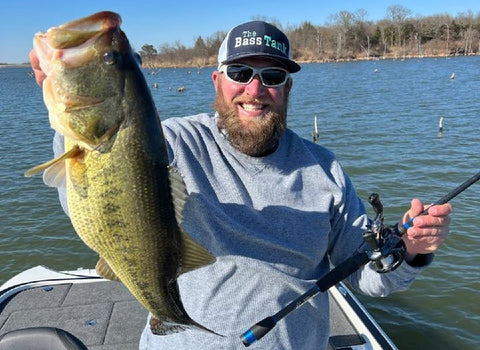
We interviewed John Soukup about fall fishing with one caveat… He had to avoid the generalities you always read about in bass articles. “Back of the creeks” type stuff… blah blah. Soukup agreed to get into detail, which isn’t hard for him (his brain operates like a computer with multiple processors.) So starting with bait details, we jump into this fall education.
Small Baits
“Well, when does most bait usually spawn? After the bass spawn, right. So, as fall comes around, most of this season’s hatch is finally getting big enough for bass to target. They’re an easy meal, and bass will focus on bait with smaller profiles. That’s when I’ll go to smaller swimbaits, jerkbaits and crankbaits.”
Bass will move to back of bays as the transition towards winter happens, but not immediately. During his top 10 finish at the Grand Lake Bass Open, Soukup was targeting the upper portion of the water column, but out farther from the bays. The bait was still working from their summer patterns towards the backs, but they were still relating to summer locations. During this event, the bait was in the top 3 feet of the water column, so he would adjust his LiveScope transducer up about 10% to see those bass more clearly.
The bait of choice was jerkbait, a small one. Soukup is well known for the money he’s won chasing suspended fish around with a livescope and jerkbait. But you don’t have to be out in the middle of nowhere chasing them around with forward imaging.
“In the beginning of fall, the bass are following the bait from their summer locations, on their way towards the back. In the mornings I would concentrate on bluff walls that lead to back of creeks, and in the afternoons I’d let the sun compress them into the flats around those areas and catch them with topwater. Most important at any time during the fall season is… find the bait. It can be in the back or out in the main lake.”
Cover Ground
“This time of year, and really until winter season hits, fish are scattered and moving. It’s a good idea to cover water and pick off the aggressive ones. I try to fish as much shallow rock and isolated wood as I can. My baits of choice are buzzbaits, chatterbaits, small crankbaits and of course the jerkbait. Riprap as an example, holds heat the longer and is usually the last source of algae which attracts baitfish.”
“I like to throw a small little crankbait during this time of year, and I actually started using the Alpha Angler Slasher to throw it on. The Slasher is great for jerkbaits, but it’s also perfect for those light little crankbaits thrown tight around cover… down laydowns, around rocky cover.”
“If I could only have two rods for the fall transition, it would be a Zilla and the Slasher. The Zilla is a great cover-oriented buzzbait rod, as well as light flipping. The Slasher is, well... my favorite Alpha rod. The first thing I noticed about it was accuracy… actually all Alpha rods seem to be exceptionally accurate, but the Slasher allows for dead on casts. It’s important in the fall, then when chasing isolated cover, you can’t be 5” from the cover. You need to be 1” from cover.”
Reeling Clean
“When the bait uses the top of the water column like they do in the fall, I move the transducer of my livescope up 10% or more. The standard setting on the transducer can miss the top foot or two, and that’ll cause you to miss fish. Another thing I do is use the emerald green pallet on my Garmin. That seems to provide the best return in this situation for both bait and fish.”
“Unlike other times of year, you don’t need to hit cover to generate strikes in the fall. Bobby Lane won Redcrest last year throwing a crankbait and “reeling clean.” The bait never touches cover, but as it goes by bait-hunting bass, they snap at it. For some people that’s a hard thought process to accept. We’ve all been taught to hit cover with our cranks.”
“Gear wise, I use Sunline for my mainlines. 12lb Shooter for the jerkbait and 14lb for the little crankbait. If I find fish using the riprap or nasty cover, I’ll step up to 16lb Shooter on the crankbait. 7.1:1 speed Daiwa reels attached to the Alpha Angler Slasher. Probably my favorite little crankbait this year has been the Booyah XCS in Chart Black or Foxy Shad. A really good trick is to put a feather on the back of the crankbait. The fish are feeding up, and the feather helps the profile and keeps the bait high in the water column.”
Hopefully some these tips help you catch more fall bass. Of all the people we spoke to about bassin’ during the fall, the most consistent sediment was covering water. The bass just don’t bunch up until late fall/winter, so looking for the miracle school probably won’t deliver much. You’ll need to put your head down and make 10,000 presentations.





